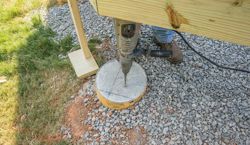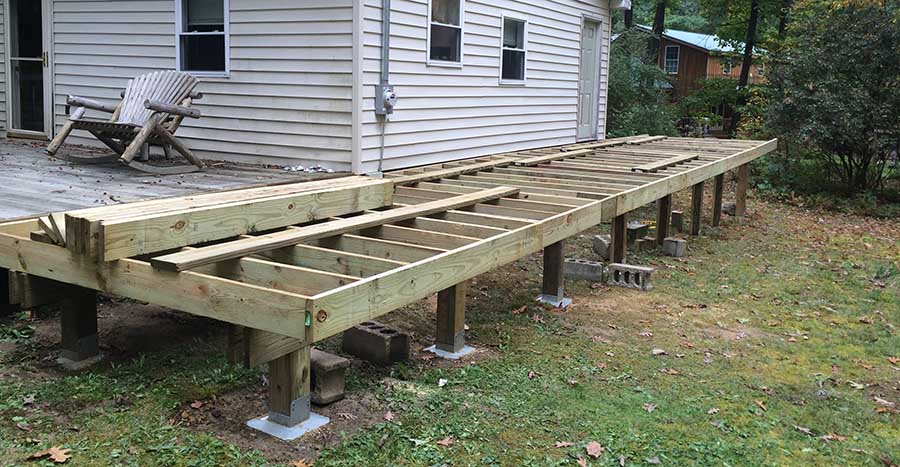Choosing the Right Deck Footings for Stability and Resilience
The long life and safety of your deck depend greatly on the kind of footings you select, as they offer the necessary assistance and security to stand up to the test of time. In this discussion, we will discover the various kinds of deck grounds, consider the crucial factors to weigh when making a choice, and dig right into the pros and disadvantages of various options.
Types of Deck Grounds
There are several kinds of deck grounds that can be made use of, each offering unique advantages and considerations. One typical type of ground is the concrete pier footing. These footings include a cylindrical hole loaded with concrete, which gives a strong structure for the deck blog posts. Concrete pier footings are relatively easy to install and use excellent security, making them a popular choice for many deck tasks.
One more kind of ground is the helical pile footing. Helical piles are steel shafts with helical plates affixed to them. These footings are mounted by screwing them right into the ground, which develops a safe and secure structure for the deck. Helical pile footings are suitable for locations with tough dirt problems, as they can be mounted in virtually any kind of soil. They likewise permit very easy change and leveling of the deck if needed.
Alternatively, some builders choose precast concrete grounds. These grounds are made of sturdy concrete and come in various sizes and shapes to fit different deck layouts. Precast concrete footings are practical to mount and provide a steady base for the deck framework.
Lastly, one more choice is the post-in-anchor ground system. This type of footing involves driving a steel support right into the ground and affixing it to the deck article. It offers adaptability in terms of positioning the deck messages and is ideal for decks with light-weight frameworks.
When picking the ideal kind of deck ground, it is vital to think about variables such as dirt problems, deck load, and regional building codes (Deck Footings). Consulting with a professional service provider or structural engineer can assist make certain the appropriate ground is selected for a steady and risk-free deck
Aspects to Take Into Consideration When Selecting Grounds
When choosing the proper footings for a deck, it is crucial to carefully consider various aspects such as dirt conditions, deck load, and adherence to regional structure codes. These aspects play a substantial function in guaranteeing the security and sturdiness of the deck structure.
The type of dirt on which the deck will be constructed determines the type of footings needed. On the various other hand, decks constructed on clay or large soils may call for grounds that can fit the dirt's tendency to increase and agreement.
One more vital variable is the deck lots. The weight of the deck, consisting of the products used and any type of possible live lots such as furniture or gatherings, need to be considered when selecting footings. The grounds should be created to birth the weight of the deck and distribute it evenly to avoid any kind of architectural problems or failings.
Last but not least, adherence to local building ordinance is vital. Building ordinance differ from region to region, and it is important to abide with the details requirements set by the neighborhood authorities. Deck Footings. These codes make certain that the deck is developed securely and meets the required requirements for architectural honesty and load-bearing capability
Concrete Grounds: Cons and pros

Concrete grounds supply numerous check out this site benefits and drawbacks when used as the foundation for a deck. On the favorable side, concrete grounds give excellent security and resilience.
Another advantage of concrete grounds is their convenience. They can be poured right into various sizes and shapes to suit different deck layouts and arrangements. Concrete grounds can be customized to fit the particular demands and needs of the deck structure.
Nonetheless, there are also some drawbacks to utilizing concrete grounds. This can enhance the total cost of the deck task and may call for specialist aid.

Helical Piers Vs. Sonotubes: Which Is Better?
In thinking about the structure choices for a deck, the contrast in between helical piers and sonotubes is crucial in figuring out the premium selection. They are twisted into the ground utilizing hydraulic machinery, supplying a resilient and stable foundation for the deck.
When it concerns security and sturdiness, helical piers have the upper hand. The helical plates on the piers create a solid grip with the dirt, preventing any kind of motion or shifting of the deck. This is especially valuable in locations with unpredictable or changing soil problems. Sonotubes, on the other hand, count exclusively on the concrete filling for stability, which might not supply the very same level of toughness and resistance.
In regards to setup, helical piers are reasonably much easier and faster to install contrasted to sonotubes. The hydraulic equipment used to turn the piers right into the ground guarantees a effective and fast procedure. Sonotubes, on the other hand, need excavating holes and putting concrete, which can be labor-intensive and lengthy.
In addition, helical piers are a more flexible alternative. If needed, they can be made use of in various dirt problems and can be readjusted or reinforced. Sonotubes, on the other hand, may need additional learn this here now assistance, such as rebar, in particular dirt problems or areas with high load demands.
Picking the Right Footings for Your Deck's Dimensions
For ideal structural stability, it is essential to thoroughly choose the proper footings that line up with the dimensions of your deck. The dimensions of your deck, including its elevation, size, and size, play a significant role in figuring out the kind and size of footings required.
When selecting footings for your deck, it is essential to consider the load-bearing capability of the dirt. The weight of the deck, integrated with the weight of any type of furniture or people on it, exerts a significant force on the grounds (Deck Footings). Therefore, it is essential to select footings that can sufficiently support this weight without sinking or shifting with time.
Bigger decks with higher measurements need bigger footings to give adequate security and support. The form of the footings, whether they are square or rounded, depends on the design and design of the deck.
Conclusion
In conclusion, choosing the ideal deck grounds is crucial for guaranteeing stability and durability. Elements such as the kind of grounds, the deck's measurements, and the pros and disadvantages of various options should be thought about.
These grounds are composed of a round opening loaded with concrete, which gives a strong structure for the deck messages. Concrete pier footings straight from the source are reasonably easy to install and provide exceptional stability, making them a prominent option for numerous deck jobs.
Precast concrete footings are practical to install and offer a steady base for the deck framework.
It uses versatility in terms of positioning the deck messages and is suitable for decks with light-weight structures.
Concrete footings offer several benefits and negative aspects when made use of as the structure for a deck.